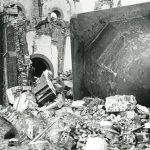The USAAF sought an aircraft that could fly longer distances while retaining the Mustang’s performance characteristics—so North American simply fused two P-51s together.
The Second World War was a horrible conflict. It was also remarkable–in the sense that it led to a period of extreme technological development and innovation, advancing human technology faster in five years than peaceful society had in twenty.
Of course, the results of this innovation were not always positive for humanity. Everyone thinks of the Nazi wünderwaffe when they think of the technological innovations of the era. But far fewer think of the incredible—practical—technological developments that occurred within the U.S. military and its attendant defense contractors.
The North American F-82 Twin Mustang stands as a distinctive example of the intriguing military innovations that World War II kicked off. Designed as a long-range escort fighter and all-weather interceptor, the F-82 was a bold experiment in extending the legacy of the iconic P-51 Mustang. Its unconventional twin-fuselage design and operational history make it a truly fascinating weapons platform to assess today.
Combining Two P-51 Mustangs Into One
Born out of the United States Army Air Forces’ (USAAF) need for a long-range escort fighter capable of accompanying bombers on extended missions—particularly in the Pacific Theater, the F-82 was predicated upon the design of North American Aviation’s iconic P-51 Mustang.
Indeed, the aircraft did not even need a new fuselage. The USAAF sought an aircraft that could fly longer distances while retaining the Mustang’s performance characteristics—so North American simply fused two P-51s together.
The result was one beastly-looking yet dynamic warbird. By joining two P-51 fuselages with a central wing and a horizontal shared stabilizer—vaguely resembling the P-38 Lightning, another successful twin-fuselage aircraft—North American could create an aircraft with double the fuel capacity, extended range, and the ability to carry two pilots, enhancing crew endurance and operational flexibility.
The USAAF approved the project, and the XP-82 prototype bird first flew on June 26, 1945. The end of WWII, however, shifted the F-82s role from a wartime escort to a postwar interceptor and reconnaissance platform, aligning with the emerging needs of the newly established U.S. Air Force (USAF).
Double the Plane, Double the Power
A visually striking aircraft, each fuselage of the fused P-51s retained the sleek lines of the original aircraft, complete with its own cockpit, engine, and landing gear. Two Packard V-1650 Merlin engines powered this plane at the outset. Later models, though, came equipped with Allison V-1710 engines due to postwar shortages of the Merlin engines. These power plants gave the F-82 a top speed of around 460 miles per hour and a range exceeding 2,200 miles, making it one of the longest-range piston-engine fighters of its era.
The dual cockpit design was especially memorable. The left cockpit housed the primary pilot, responsible for flying the aircraft, while the right cockpit was occupied by a co-pilot or navigator, who could assist with navigation, radar operation, or even take control during long missions. This setup reduced pilot fatigue on extended flights, a critical advantage for missions lasting up to 12 hours.
The F-82 was heavily armed, coming equipped with six .50-caliber machine guns mounted in the center wing section, along with the ability to carry bombs, rockets, and external fuel tanks. Later variants, like the aforementioned F-82G, were fitted with radar for all-weather and night operations, transforming the aircraft into a capable interceptor.
The F-82 Saw Combat in Korea
Although the F-82 arrived too late to see combat in WWII, it played a significant role in the early years of the Cold War between the United States and its former WWII allies, the Soviet Union. Notably during the Korean War, the F-82 played a pivotal role. Stationed in Japan during that conflict, F-82s were among the first American warplanes to engage North Korean forces following their invasion of South Korea in June 1950. On June 27, 1950, an F-82G from the 68th Fighter Squadron scored the first aerial victory of the war, shooting down a North Korean Yak-9.
The F-82’s long range and ability to operate in adverse weather conditions made it invaluable for escorting bombers, conducting reconnaissance, and performing ground-attack missions. After Korea, the F-82 served in various air defense roles, patrolling the skies over the United States and Alaska. Its radar-equipped variants were particularly effective as interim night fighters, bridging the gap between piston-engine aircraft and the jet-powered interceptors that would soon dominate air forces worldwide.
The F-82 also set a notable record in February 1947, when a modified P-82B, named Betty Jo, completed a nonstop flight from Hawaii to New York, covering 5,051 miles in 14 hours and 32 minutes—a record for piston-engine fighters at the time.
The Jet Engine Killed the F-82
Although short-lived, the F-82 was an impressive warplane. It proved itself during the Korean War, even though that was not the conflict it was designed to fight. Had the Second World War continued longer than it did, the F-82 would have undoubtedly been exceptionally useful for the military in its intended role.
Ultimately, the age of the jet engine cut the F-82’s operational lifespan short. The F-86 Sabre and F-94 Starfire ended the F-82’s operational life. It was truly a transitional plane from the propeller-driven era of warplanes to the jet engine era.
Today, there are few F-82s still around. But you can still see this masterpiece on display—in its fully restored glory—at the National Museum of the United States Air Force in Dayton, Ohio.
About the Author: Brandon J. Weichert
Brandon J. Weichert, a Senior National Security Editor at The National Interest as well as a contributor at Popular Mechanics, who consults regularly with various government institutions and private organizations on geopolitical issues. Weichert’s writings have appeared in multiple publications, including the Washington Times, National Review, The American Spectator, MSN, the Asia Times, and countless others. His books include Winning Space: How America Remains a Superpower, Biohacked: China’s Race to Control Life, and The Shadow War: Iran’s Quest for Supremacy. His newest book, A Disaster of Our Own Making: How the West Lost Ukraine is available for purchase wherever books are sold. He can be followed via Twitter @WeTheBrandon.
Image: Shutterstock / Dan Simonsen.

















